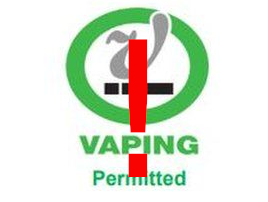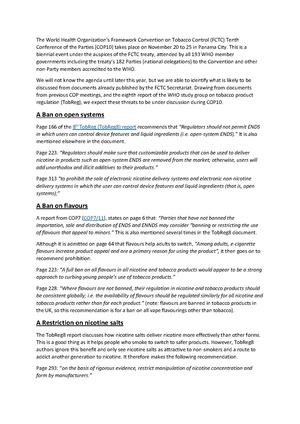Call To Action: The World Health Organization is planning a global assault on vaping


NNA have listed the threats in more detail in this file (PDF Shown in preview) along with accompanying quotations from WHO documents which will be the basis for discussion at a global conference to be held in November. We have also produced a playlist of animations explaining the threats. YouTube Playlist
Although that seems a long way off, we must ACT NOW to get our voices heard. Plans for the meeting are already in progress and by the time the agenda is published in September it will be too late. Decisions will have been made, national delegates will have been selected, and countries – including the UK – will have discussed their policy positions for the event.
We are asking for all those who have concerns to start writing NOW to protect the most successful alternatives to smoking against blind, unscientific, and ideological hostility from the WHO.
About the meeting:
The World Health Organization’s Framework Convention on Tobacco Control (FCTC) Tenth Conference of the Parties (COP10) takes place on November 20 to 25 in Panama City. This is a biennial event under the auspices of the FCTC treaty, attended by all 193 WHO member governments including the treaty’s 182 Parties (national delegations) to the Convention and other non-Party members accredited to the WHO. The UK is not only a signatory to the FCTC, but it is also a major funder of related activities. You are paying for it so have a right to ask to be involved.
We will not know the agenda for the COP10 meeting until later this year, but we are able to identify what is likely to be discussed from documents already published by the FCTC Secretariat, which oversees administration of the treaty.
Decisions are made on consensus, not by voting, so if no objections are received the proposals will be approved. Parties who attend are expected to incorporate the decisions into their national laws. The treaty is legally binding so if a country does not abide by decisions at the meeting, political weight will be on politicians to do so because attendance is taken as agreement with the consensus.
How you can stop them:
Although the proposals have been formulated by the FCTC Secretariat and their reports circulated to signatories to the treaty, it is the Parties who make the decisions. The Secretariat can only advise and must do what the national delegations decide.
The UK delegation to the conference, as with all other national delegations, is instructed by the country’s government which, in turn, is answerable to you, the electorate. To ensure that these threats are rejected in November, you must start writing now to express your concerns to your elected representatives and those involved in the COP10 process in the UK.
What to do:
There are several things you can do to make your voice heard.
- Write to your MP and express your objections to these real threats.
Tell them why the products are so important and why WHO threats must be resisted. Ask them to pass on your concerns to the government and insist the UK stands up for vaping and other non-combustible nicotine alternatives to smoking. The UK delegates may or may not have been selected already but ask your MP to enquire who is on the delegation so you can write to them.
You can find your MP’s contact details at the UK parliament website or send your message using writetothem.com.
- Write to the FCTC “focal point” person in the UK
Each country which sends a delegation to the conference has a “focal point” person who passes information between the FCTC Bureau and the national government. Tell the focal point that you wish to know what current plans are being communicated from the FCTC Bureau to the UK government and vice versa. Ask them for updates, meeting minutes and other information about the COP10 process.
The UK focal point is Alison Walker (healthybehaviours@dhsc.gov.uk). If you are not from the UK, you can find your focal point by going to this page, selecting your country from the drop-down menu, and clicking on the 2020 report. The focal point is the first name on page 1, with their contact address and email(s).
- Be polite but persistent, tell your story
It is always important to be polite when contacting MPs, focal points, and other political influencers. If you are a consumer, do tell your story about how reduced risk products work for you. It is likely that you will not get the answers you want straight away but, if so, write again to ask for a dialogue and to be updated about developments related to the COP10 meeting. If you feel you have not been answered adequately, reply to emphasise that you consider this to be important and you wish your concerns to be taken seriously.
- Share your letters and replies with NNA
Do share your letters with NNA and any replies that you receive. As the year progresses, the COP10 process will evolve and we will give updates on the NNA website. Your actions can help us to assess what is happening and enable us to advise what supporters and consumers can do next to head off the WHO’s threats. You may also send us copies at info@safernicotine.wiki and we will pass them along.